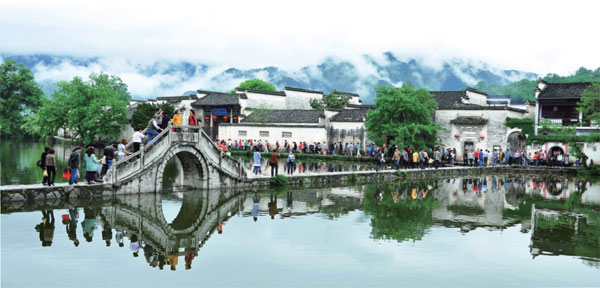Province promises rich blend of natural delights
|
Hongcun in southern Anhui welcomes millions of visitors to view its ancient residential buildings. Photos Provided to China Daily |
|
A dragon boat race takes place in Sanhe ancient town in Feixi county. |
|
The Zuiweng Pavilion, or Drunken Old Man's Pavilion, in Chuzhou has become famous because of a verse by Song Dynasty poet Ouyang Xiu. |
|
The Tianzhu Mountain, or Heavenly Pole Mountain, is one of the landmark attractions in Anhui. |
|
The Tiantangzhai Scenic Area is a national-level nature reserve and geological park. |
Anhui province in eastern China is blessed with natural gifts, a rich history and abundant tourism resources to cater to the many visitors attracted by its delights.
Tourists planning a visit to Anhui might first think of Huangshan Mountain, a world cultural and natural heritage site listed by UNESCO in 1990.
This is the landmark attraction in Anhui and one of the most famous mountains in China.
As an ancient Chinese saying goes, "Visiting the five holy mountains in China makes its unnecessary to visit other mountains, and a visit to Huangshan makes it unnecessary to visit the five holy mountains."
The Huangshan Mountain scenic area in southern Anhui province covers an area of 160.6 square kilometers. Its three major peaks, the highest Lotus Flower Peak, the precipitous Celestial Capital Peak and the flat Bright Summit Peak, are all at altitudes of more than 1,800 meters.
The tourist destination is known for peculiarly-shaped rocks, pine trees, hot springs, winter snow and views of the billowing clouds above.
Huangshan pine trees (Pinus hwangshanensis) typically grow at moderate to high altitudes on steep, rocky crags and are a major part of eastern China's striking landscapes. Many of the trees have their own names, such as the renowned Welcoming-Guests Pine, which is thought to be more than 1,000 years old. Its name comes from the tree's resemblance to a warm host stretching out their arms to welcome visitors. Its image appears as a decoration in restaurants and homes all over China and a huge iron relief of the tree is exhibited in Anhui Hall in Beijing's Great Hall of the People.
The view from the mountaintops is known as the Sea of Clouds, because of the clouds' resemblance to an ocean. The views, pine trees, granite peaks and rocks resemble magnificent, natural paintings, and the trees themselves have been frequently depicted in traditional Chinese paintings.
Huangshan Mountain, together with the Yangtze River, Great Wall and Yellow River, are outstanding examples of China's breathtaking natural wonders and culture.
The mountain has also attracted some of China's most notable figures, including Li Bai, a poet of the Tang Dynasty (618-907), Xu Xiake, a geographer and explorer of the Ming Dynasty (1368-1644), as well as former premier Zhou Enlai.
Another landmark attraction in Anhui is Jiuhua Mountain.
Jiuhua Mountain, with its 99 temples, nearly 1,000 monks and nuns and more than 10,000 Buddhist statues, is one of the four great Buddhist Mountains in China.
It is also a noted mountain in cultural and historical terms. More than 20 academies of classical learning have been successively established there since ancient times, and there are more than 2,000 extant cultural relics and some 500 related poems and essays written by some of China's renowned writers and scholars from past dynasties.
The Tianzhu Mountain in Qianshan county, also called Mount Wan, is the place from which the abbreviation of Anhui - "Wan" - derives.
Tianzhu Mountain has 45 peaks which are 1,000 meters above sea level. Its highest point has an elevation of 1,760 meters.
One of the famous sites of Tianzhu is the Mystery Valley. It is a valley formed by rocks falling from the mountain. The valley has 53 caves, forming a very complicated maze.
As Confucius wrote in his Analects: "The wise enjoy water, the humane enjoy mountains." Those who wish to draw wisdom from nature may, therefore, go to Chaohu Lake in central Anhui.
Chaohu Lake, one of China's five biggest freshwater lakes, covers an area of nearly 800 square kilometers. It abounds in aquatic resources and its silver fish, shrimps and crabs are known as the "Three Treasures".
The lake is also noted for its gorgeous scenery. A cluster of white wild peonies can be seen on the cliffs of Yinping Mountain on the lake's southern bank. Peonies have been growing on the same spot for more than 300 years.
Other attractions
Langya Mountain
The mountain is in the southwest region of Chuzhou city. Winding paths leading to secluded places can be found in the scenic area, which covers an area of 35 square kilometers. It is also home to a wealth of flora and fauna. The area boasts rich cultural attractions such as Langya Temple, which was originally built in the Tang Dynasty (618-907) and Zuiweng Pavilion, constructed in the Song Dynasty (960-1279). The Song Dynasty poets Ouyang Xiu and Xin Qiji both served as officials in Chuzhou and wrote celebrated poems and essays praising the mountain.
Tiantangzhai Scenic Area
The area is a national-level nature reserve and geological park. It is said to be the last primitive forest in East China, with a diversity of plant life. It covers 120 sq km and has 25 peaks at an altitude of more than 1,000 meters. The highest peak in the area is a main peak of the Dabie Mountains, which form the main watershed of the Yangtze and Huaihe rivers. Tiantangzhai is an ideal place for travelers who are looking to get closer to nature.
Taiping Lake
The lake lies at the northern foot of Huangshan Mountain. It is the largest artificial lake in Anhui, covering an area of 88 sq km. It is surrounded by mountains and more than 10 islands dot the center of the lake. Forest coverage in the Taiping Lake Scenic Area surpasses 95 percent and the area is home to more than 580 wild plants.
Shexian county
The region has been home to many renowned historical figures including art historian and painter Huang Binhong and educator Tao Xingzhi. It is noted for the Xin'an School of Painting, Xin'an School of Traditional Chinese Medicine, Hui School of Sculpture and the Huizhou branches of Chinese cuisine. Shexian county has numerous historical sites and relics such as memorial archways, ancestral halls and ancient villages featuring houses built several centuries ago.
Sanhe ancient town
The town in Hefei traces its history back more than 2,500 years and its present name derives from the fact that three rivers - Fengle, Hangbu and Xiaonan - meet there. It boasts a number of well-preserved old buildings, abounds with folk culture and is home to Luju, a local opera in Hefei, capital of Anhui, also a national intangible cultural heritage item.
(China Daily 04/11/2017 page26)




















